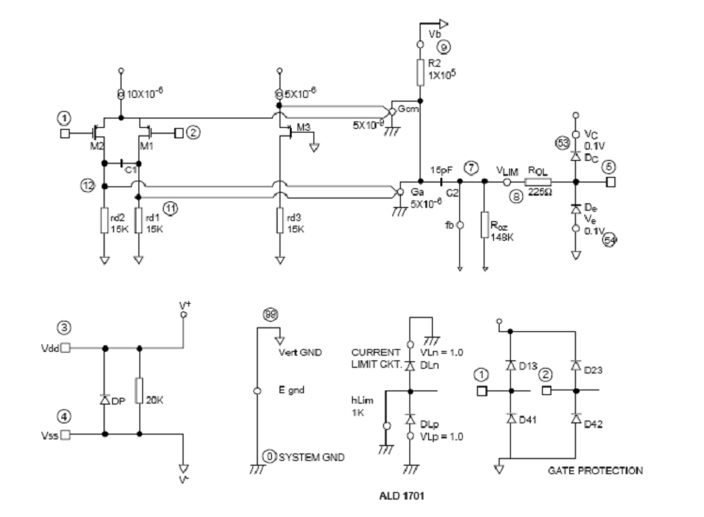| |
|
OpAmp Macromodel Library |
| |
|
The increasing power of computer hardware and simulation software has led to the widespread proliferation and use of analog simulators. ALD recognizes this and has designed a SPICE library containing models of ALD's linear elements, such as operational amplifiers, to facilitate easier and more accurate simulation by our customers.
Macromodel Definition
With any computer simulation, there is a trade-off between accuracy and convenience. A transistor level SPICE operational amplifier model would require extremely long simulation times and be prone to convergence problems. A very simple model would simulate quickly, but the results would be inaccurate. The macromodel is a good compromise, suitable for most engineering applications. The macromodel uses transistors in the input stage and ideal SPICE elements in the rest of the model. Ideal SPICE elements include voltage controlled voltage and current sources, resistors and capacitors. This combination reduces the number of active devices while providing a reasonably accurate model.
Using ALD Macromodels
The macromodels were designed, written and tested on MicroSim's PSPICE, version 4.03. The instructions that follow are specifically for PSPICE. Tailor your macromodel implementation to your software package. The ALD macromodels can be used on any SPICE program that uses SPICE 2G.6 format. If your syntax should happen to be different, it should be easy to modify the macromodels to suit your system.
Each of the different ALD macromodels is for a different amplifier. These macromodels should be implemented on your computer system in different ways depending on your level of usage. If you are only going to use a model a few times, type it directly into your circuit file. If you are going to use it more than a few times, you may want to set up a library system. To do this, type each operational amplifier macromodel you will use into a single file with a .lib extension. (e.g.ALD.lib) then, in your circuit file, access the macromodel you need with a subcircuit cell. For example, set up file ALD.LIB, then in your circuit file use
|
 |
*ckt simulation
•
• Lib ALD.Lib
•
x1 2 7 9 18 24 ALD1701(where ALD 1701 is the model name of the subcircuit)
This statement matches the five nodes you specify to the five operational amplifier inputs shown below:
The only other thing you need is a statement telling SPICE where to look for the library file. To do this, use the following statement in your circuit file.
.lib c:/path to the ALD library
(e.g. .lib c:/ PSPICE/ libraries/ ALD/ALD.lib)
This method allows use of the ALD models as sub-circuits without having to put them in every file.
Finally, if you plan on heavy use of the ALD macromodels, all of the ALD models are available on diskette and are a part of the ALD design kit. |
 |
Potential Problems
With any computer models there are difficulties encountered that would not be present in the use of as actual physical device. These difficulties can range from a missing period in the circuit file to limitations of the simulator’s ability to adequately simulate complex systems. The ALD macromodels do represent typical device behavior and they do not model every op amp parameter. Consequently, care must be taken during simulation. Most problems that occur can be placed under one of three categories.
1. Hardware or software problems related to the user's system
Such problems would include improper SPICE configuration and errors in the circuit file."
2. Problems related to the simulation application
These problems are sometimes very complex. Such problems include: failure of simulation to converge, simulation does not model a certain parameter or the simulation behaves incorrectly. These problems involve the simulator, the model and the application of the model in a very interrelated way.
3. Problems with the model itself
It can be difficult to distinguish these problems from type 2. It includes only model errors, not slight model inaccuracy or the failure of a model to model certain parameters.
Because ALD is in the business of supplying integrated circuits, not SPICE macromodels, we only provide limited support for our models. Obviously, ALD cannot be responsible for Category 1 errors. Category 3 errors (should any exist) will be addressed by ALD at our discretion. The most difficult errors to address are those that come under Category 2. It is crucial that all customers isolate the source of such errors before contacting ALD. Although the company believes the models will be more than adequate for almost all simulation needs, they are supplied on an "as is" basis and we do not guarantee the models will model every possible operational amplifier behavior with accuracy. We do guarantee the model to have been thoroughly tested by our engineering staff and we have encountered no errors. If a model is not to your liking, it can be easily modified by the user. Of course, simulation problems can be tricky and elusive. However, ALD recommends using the simulator and various system simulations as guidelines for engineering evaluation prior to building a breadboard where the "true" system parametric and performance can be verified.
Details of the Macromodels
PSPICE contain a program called Parts. Parts can create a macromodel given operational amplifier parameters. Our
macromodels began with the Parts model, but were extensively modified to provide a more accurate model of the attributes for each ALD op amp.
An example of the circuit ALD macromodel is shown on previous page.
The following parameters are modeled with ALD's macromodels:
VOM+, VOM-, AV, CMRR, IOSAT, slew rate, rise and fall times, overshoot, output resistance, bandwidth, phase margin, common mode input voltage range, output voltage range, input diode clamping and input capacitance.
Some of the parameters not modeled include:
VOS, IOS, noise, and PSRR.
Conclusion
For the designer interested in off-the -shelf parts, this provides a powerful design simulation tool. For those involved in ASIC design with our Function-Specific program these macromodels add yet another level of power, flexibility and convenience. |
|
|